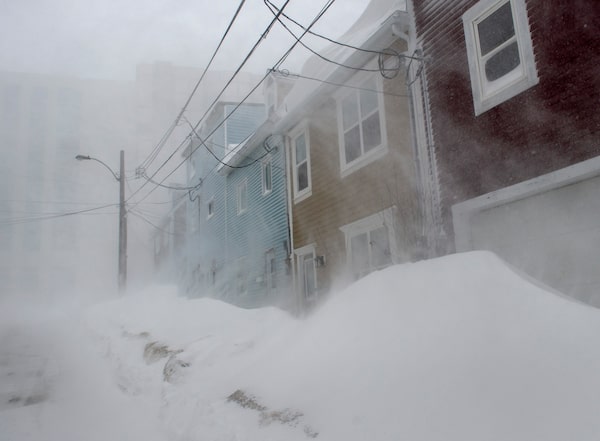
High winds and heavy snow cause white out conditions in St. John’s on Jan. 17, 2020.Andrew Vaughan/The Canadian Press
Luke Quinton is a writer and audio producer based in St. John’s.
It was just a ridiculous storm. Preposterous beyond all expectation and sense.
It had already snowed all day across the St. John’s metro, when late on Jan. 17 the wind gusts peaked at an estimated 157 kilometres an hour, howling up the narrow canyon of row houses on our street, whipping around power lines like jump ropes. A blue-green light flashed a few streets away and our lights flickered. A sustained power outage was our biggest fear.
When we woke the next morning the power was still on, but there were delicately curved drifts squatting on top of our neighbourhood. Dunes of microscopically small snow, almost dust, absolutely everywhere.
It’s not like we’ve never seen a storm before. The open Atlantic sees to it that we do. It’s just been a long time since we saw a storm that sent us back to a previous century. Every home suddenly had its own personalized iceberg parked outside, blocking doors and looming above first-floor windows.
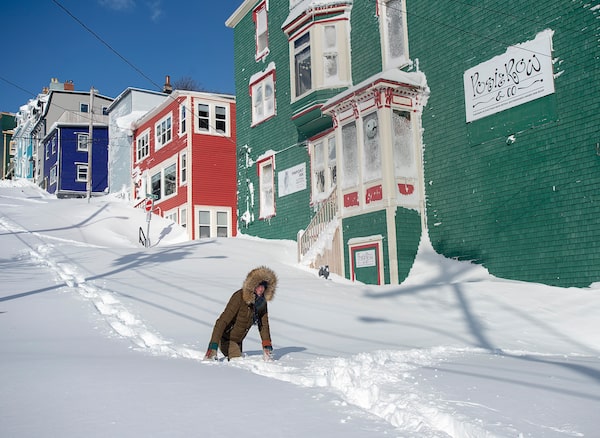
A resident makes her way through the snow in St. John’s on Jan. 18, 2020.Andrew Vaughan/The Canadian Press
Our next door neighbour couldn’t get out of her house – she was dug out by friends. My wife ventured out and realized she was walking on top of a neighbour’s car. We started to help dig out neighbours as countless others did the same around us, a spontaneous shovel party, digging away in disbelief, to tunnel a path under 12-foot drifts to our front doors.
These were amazing moments. We later pulled our toddler on a sled over snowdrifts that had carved ledges at each intersection. People were everywhere. A couple had installed themselves in the middle of an intersection, getting ready to smoke a joint. We met friends trudging up the street on snowshoes, heading to a party. When we got to Circular Road, which became the poster child for the storm, we saw not just buried cars, but half-buried houses. Our friends had dug a hole upward, out their front door. They said their neighbours had emerged in the sunlight at the same time, like gophers. Their road wouldn’t be plowed for days.
There were several kinds of people in our postapocalypse. The kind who went bombing their Ski-Doos down major avenues in broad daylight or built a bonfire where an intersection used to be. And the kind who found the state of emergency constricting and scary.
A pile of snow outside a garage in St John's on Jan. 18, 2020.J. DAVID MITCHELL/Reuters
Having your life upended can feel disorienting. But having the rhythm of your life broken can also be a liberating thing. St. John’s state of emergency effectively banned cars in the city, with some exceptions for emergencies. It lasted eight days. Without cars, we suddenly had a neighbourhood that looked more like it did a hundred years ago: You could trust your child enough to let her wander in the middle of the street (such as it was). When the cars came back, it felt like an intrusion. I had no idea how much of my time outside was spent watching out for cars ready to turn a corner and smoke me.
We had moments of pure joy. We planned a potluck with our friend and neighbour, Andie, and a sprawling group of friends and strangers came through our door bringing the goods: casseroles, chili, soup, gin and blueberry crumble. Despite being neighbours, probably half of us had never met. The storm fixed that at least.
New organizations were popping up. Shovel brigades headed out, digging out those who needed it. In the postapocalypse, many of the most important roles are filled by artists, of course. Filmmaker Ruth Lawrence ran our shovel brigade with a spritely touch.
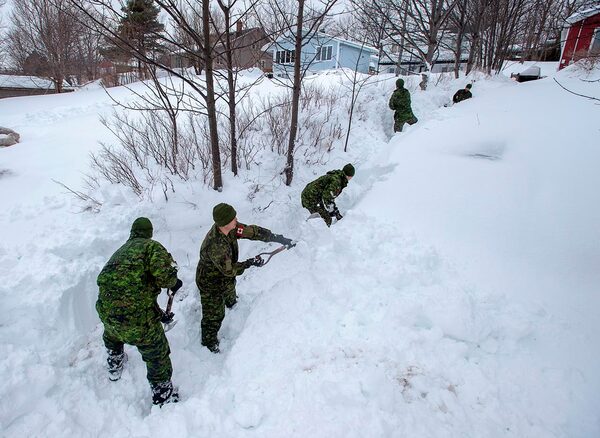
Soldiers from the 4th Artillery Regiment based at CFB Gagetown clear snow at a residence in St. John’s on Jan. 20, 2020.The Canadian Press
What we didn’t yet fully grasp was that the state of emergency was itself causing a life-or-death emergency for some.
The state of emergency had closed practically all businesses in the city. For some reason, whether simply confusion or the storm itself, for several days, this included food banks and community kitchens.
My friend Kathryn Lear noticed that some folks she would occasionally take to a methadone clinic seemed to be in rough shape. “They looked close to death,” she told me.
Even once grocery stores were allowed to open, parts of the city were still at a standstill. Mail hadn’t been delivered in days. People were waiting on assistance cheques. Others hadn’t been able to work.
Ms. Lear mobilized as part of a food sharing pop-up called Stone Soup, to check on people the city and province evidently forgot. They quickly got to work gathering donations and sending out hampers. When Ms. Lear delivered food to one apartment building, she said “a lot of the guys were done eating before we left the building.” There were requests from all across the city by mothers looking for formula, others just asking for bread and basic staples. Food for their cat. Toilet paper. Some hadn’t had a thing to eat for two days.
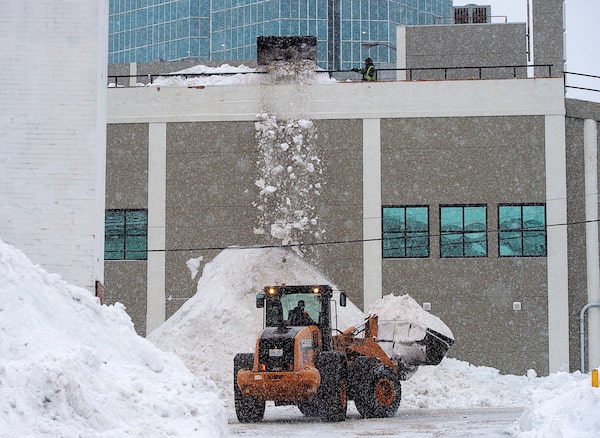
Contractors clear snow from the upper deck of a parking lot in St. John’s on Jan. 21, 2020. The state of emergency had closed practically all businesses in the city.Andrew Vaughan/The Canadian Press
What happened to let these people go hungry? Whatever ball was dropped, whoever’s job it might have been, the fact is that many, many people had no food and there was no plan to fix that.
The group’s members started leaving boxes of food in public and took anonymous requests, to help people who were reluctant to ask.
“It was amazing to see how the community came together and helped,” Ms. Lear said. “It was amazing to see how many people are living on the verge.”
This could have been worse. Stephanie Sodero, a Banting researcher who studied cases of emergency preparations in Atlantic Canada, says the Newfoundland government has consistently looked at storms as singular events instead of preparing for them to get more and more severe because of climate change. Since Hurricane Igor swept through the province in 2010, tearing out roads and stranding people for days, Dr. Sodero says the province has had “no reckoning” with the causes or the response. It simply fixed the roads and moved on. Nova Scotia, on the other hand, has looked at a decade’s worth of storms to prepare for the next ones.
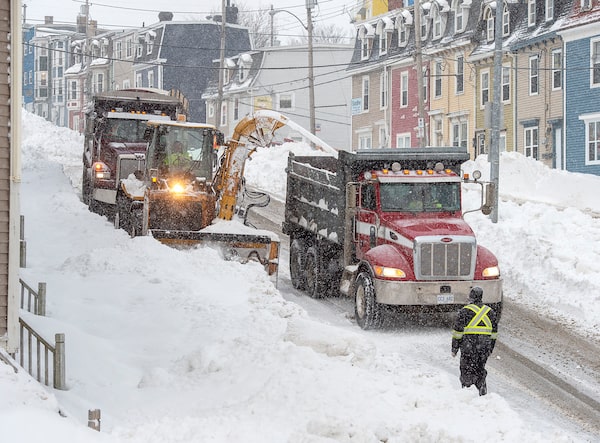
Workers continue to remove snow from the streets in St. John’s on Jan. 21, 2020. Even once grocery stores were allowed to open, parts of the city were still at a standstill.Andrew Vaughan/The Canadian Press
After Igor, politicians in Newfoundland and Ottawa praised an old chestnut: the Resilient Newfoundlander. Snowmageddon is full of these stories, nurses working days on end, shovelling heroes, women running community kitchens out of their houses. “It’s well deserved,” Dr. Sodero says, “but it’s also definitely from a lack of action from government.”
Evoking the Resilient Newfoundlander is a form of political distraction, she says. “It’s amazing, but that is not a substitute for government-led leadership on climate change.” One of her suggestions: that a citizen assembly made of experts and regular folks be formed to take stock of this storm and prepare for future ones.
There is a galaxy worth of stories to tell. Each street’s a solar system, each house a little planet with its own storm tales. Some instantly grabbed national attention: an avalanche in the picturesque Battery neighbourhood, tucked below Signal Hill; an entire city being practically buried with snow; hundreds of soldiers arriving to dig people out; snowboarders cruising down supersteep Holloway Street; a downtown district looking more like a ski trail.
The snow hit everywhere. Every nook, sliver, crevasse, under car hoods, through front doors and attics, spilling up and over houses, interrupting our work, our families, our mobility. It’s been two weeks and the dump truck engines still roar day and night, pulling snow out of drifts and into the St. John’s harbour. Good things will stay with me. A new community spirit is something to build on. But the spectre of hunger and loss is lingering too, like the snow we dumped in the harbour, bobbing to the surface. It won’t melt any time soon.
Keep your Opinions sharp and informed. Get the Opinion newsletter. Sign up today.